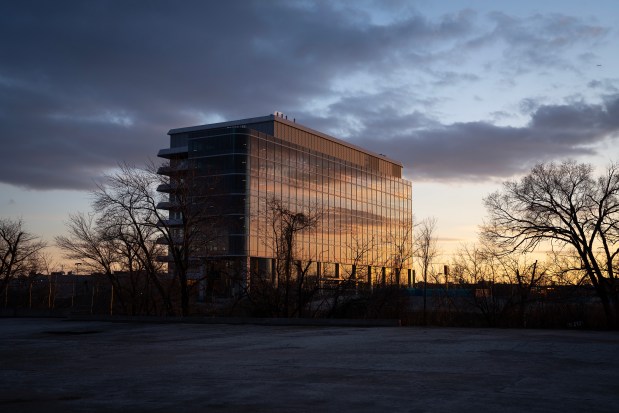News that Sterling Bay, the development firm that has struggled to realize its epic plans for the 55 acres of prime North Side real estate known as Lincoln Yards, is relinquishing about half that land to its bank lender calls to mind another high-profile city property that sat fallow far longer than people expected.
Remember Block 37?
The land bounded by State, Washington, Dearborn and Randolph streets was Chicago’s most high-profile vacant lot for nearly two decades, an embarrassing symbol of how far the city of “make no small plans” had fallen in realizing ambitious development dreams. The retail, entertainment and apartment complex now on that site came to full fruition only after four different developers had been stymied in completing what in the end turned out to be an underwhelming addition to the Loop.
Even more than Block 37, Lincoln Yards was pitched as a transformative project when Mayor Rahm Emanuel pushed to rezone the former industrial site in 2019, on his way out of office.
A whole new neighborhood sandwiched between flourishing Lincoln Park and rapidly gentrified Bucktown, Lincoln Yards was viewed as a can’t-miss proposition. Six years later, can’t miss has turned into a big whiff.
A single eight-story building, built to be a life sciences research center, located on the southern end of the site is all Sterling Bay has delivered so far, and even that building sits empty. The northern half of the land — what once was A. Finkl & Sons’ headquarters and steel plant — is what lender Bank OZK is taking back from Sterling Bay through an agreement between the parties that obviates the need for formal foreclosure proceedings, according to Crain’s Chicago Business, which broke the news late Friday. Bank OZK already has written down the $126 million mortgage to $88 million, according to a Securities and Exchange Commission filing.
In a statement, the bank — which, though based in Little Rock, Arkansas, has been one of the most active commercial real estate lenders in Chicago in recent years — made clear it was moving on from Sterling Bay. “As appropriate, we will commence efforts to patiently market this property to a new sponsor with sufficient capital and development expertise to achieve its significant potential,” it said.
Ouch.
For its part, Sterling Bay in a letter to investors expressed hope it still could work with Bank OZK to produce the full 14.5 million square feet of residential, office, retail, entertainment and other uses that got Emanuel so excited. Stranger things have happened, but that prospect doesn’t seem likely, judging from the bank’s undiplomatic statement.
Just as Mayor Richard M. Daley had to adjust his aspirations for Block 37 based on economic cycles and the abilities (or lack thereof) of multiple developers chosen to shepherd that project, policymakers in Chicago led by Mayor Brandon Johnson are going to have to recalibrate on Lincoln Yards. A megadevelopment once seen as a major commercial hub as well as a new neighborhood may well have to lean far more on housing.
If already-approved density levels are to stay the same — and that’s the value Bank OZK will have to dangle before a new developer — a Lincoln Yards project focused more on residential than commercial will raise more questions about traffic and transit. No time like the present for the city to start contemplating the implications.
What also does Bank OZK’s move mean for the $1.3 billion the city had pledged in tax increment financing for substantial public benefits Lincoln Yards was supposed to generate, including three new bridges and the reconfiguring of the problematic three-way intersection of Elston, Armitage and Ashland avenues and thus a more accessible Clybourn Metra station?
The plan for Lincoln Yards was that Sterling Bay would finance the public improvements itself and then would be reimbursed via the TIF. If a new developer takes over the northern half of the site, would they be obligated to deliver on those promised public benefits? And, even if they were, would a new developer ask for a different arrangement in light of today’s more difficult economic environment? After all, Lincoln Yards was negotiated before the pandemic killed demand for new office buildings and while interest rates were at historically low levels.
These are questions the City Council ought to be asking soon. A public hearing on the future of Lincoln Yards in light of this major development would be welcome. We’d love to hear from the city’s Planning Department, as well as Sterling Bay.
It would behoove the Johnson administration to treat this major blow to Sterling Bay as an opportunity to take a more active approach to Lincoln Yards and begin the conversation on how to get this critical project moving.
It’s 2025 now. The pandemic no longer is a legitimate excuse for the lack of progress, a conclusion Bank OZK clearly reached as well.
The irony of this unfortunate situation is that developers for decades coveted Finkl’s 28-acre site even as the city stubbornly kept it zoned for industrial use. The steel plant was razed more than a decade ago, and the tract is just dirt. The zoning is developer-friendly, some NIMBY action nearby notwithstanding.
If 10 years from now this site is still a massive vacant lot, the Lincoln Yards embarrassment will make Block 37 look by comparison a stirring success. The bank takeover of this property should serve as a wake-up call to the mayor and his economic development team.
Getting Lincoln Yards on track needs to be a high priority for a city in desperate need of more cranes in the sky and an economic narrative other than stagnation.
Submit a letter, of no more than 400 words, to the editor here or email letters@chicagotribune.com.



